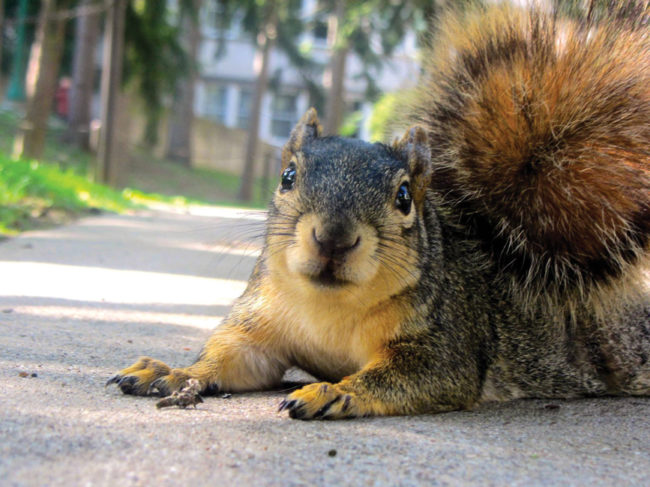
by SUSAN M. BRACKNEY
Set out even one bird feeder and you’re likely to attract a scurry of squirrels, their cheeks ballooning with seedy plunder. Fortunately, their presence can help you become a citizen scientist. Researchers are collecting data on squirrels to better understand the evolutionary effects of climate change, urbanization, and more—and you can help.
SquirrelMapper is a citizen science project co-hosted on inaturalist.org and zooniverse.org. Participants snap and submit eastern gray squirrel photos and sort thousands of images by squirrel coat color.
“Multiple people will view the same picture of a squirrel and determine … whether it’s black, gray, or some other color,” explains SquirrelMapper’s Bradley Cosentino, the Department of Biology chair at Hobart and William Smith Colleges.
SquirrelFinder—another SquirrelMapper component—encourages users to identify gray and black squirrels in different habitat types as quickly as they can.

Black Squirrels?
Turns out, some eastern gray squirrels look nearly black. Historically, “black morph” or “melanic” squirrels were common. “They were one of the prevailing color morphs, but that changed in the last 200 years,” Cosentino says. “We hypothesize that the kind of forests we have in our landscape are categorically different than the kind of forests that were here before European colonists.”
While forests of yore were packed with old- growth trees, today’s woodlands are thinner and brighter. That means black squirrels used to blend in better. But now? “People detect black squirrels faster in the younger, regrown forests,” Costentino explains.
As such, researchers are exploring the notion that predation on black squirrels living in rural woodlands is higher than it once was.
“And now, urban areas are sort of refuges for the black morph,” he adds.
City streets may be kinder to black morphs, too. “People detect black morphs faster on road surfaces than gray morphs,” he says. “The black morphs stand out more. So, does that extra second or two give a driver more time to slow down and stop before they hit those squirrels?”
Project Squirrel
Ohio-based Steve Sullivan is director of Miami University’s Hefner Museum of Natural History. He also oversees Project Squirrel. The ongoing initiative began collecting citizen scientist observations of red fox squirrels and eastern gray squirrels in the mid-1990s.
“We see that, in dense urban areas— especially within the natural range of gray squirrels and fox squirrels—it’s possible for them to identify city boundaries,” Sullivan says. “They’re not consciously saying, ‘Oh, here’s one city and there’s the next,’ but they’re responding to [urban] management practices.”
He continues, “I suspect it has to do with waste management and leash laws—both regarding cats and dogs. But we also correlate that kind of differentiation with things like street lighting.”
You can provide your own Project Squirrel observations at magbloom.com/squirrel.










